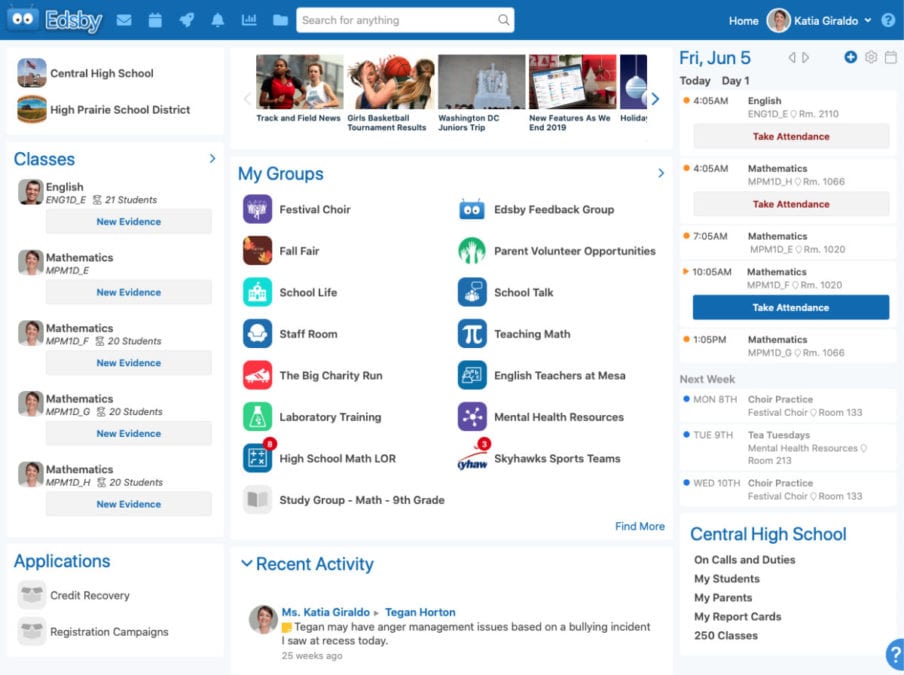When it comes to remote learning online, the Government of Nunavut is still absorbing some lessons.
A newly adopted internet-based education platform known as Edsby was pressed into use during the territory-wide two-week lockdown Nov. 18-Dec. 2.

photo courtesy of Edsby
By the end of that stretch, 16 schools still had not yet activated students' accounts to log into the program. That number fell to 11 by Dec. 7, according to the Department of Education, in the following communities: Resolute Bay, Pond Inlet, Iglulik, Sanikiluaq, Sanirajak, Baker Lake, Arviat, Chesterfield Inlet and Cambridge Bay. The two-week lockdown hampered the roll out, according to the department.
The GN spent $111,000 on the Edsby contract, including initial set-up and annual support.
John Fanjoy, president of the Nunavut Teachers' Association, said the one day of Edsby training for most educators was insufficient.
He was also critical of the platform's limitations for language instruction.
“The lack of Inuktitut capabilities on Edsby make it not a realistic option for many of our elementary teachers, and further widens the resource gap between Inuktitut and English instruction,” Fanjoy stated.
The Department of Education responded that the platform is capable of including Inuktut through the upload of documents and there are plans to include that feature, along with the associated training, during the 2021-22 school year.
James Arreak, executive director with the Coalition of Nunavut District Education Authorities, said many parents are also unprepared to cope with Edsby.
“There doesn't seem to be much opportunity for parents to work through some of the learning curves involved in such a platform... it's daunting, I'm sure,” he said. “Obviously the lack of the right learning resources in Nunavut communities is an issue.”
Arreak said teachers are primarily communicating through email when students are learning from home, but not every household has an internet connection or an electronic device for email or Edsby. For that reason, paper-based lessons seem to be easier for students and parents to deal with, he noted.
Arreak admitted that he doesn't have any “quick solutions” to a complex problem, but he suggested involving community radio as a better-known medium for many families and the use of CBs or VHF radios for interactivity.
“These are things that work. People are familiar with them and this is what you want to capitalize on if you're trying to take on an education system that's struggling at this point,” he said.
He added that the coalition of DEAs has also emphasized that learning need not be restricted to scholarly subjects. Parents are encouraged to take their children out on the land and to teach them about daily life and culture, he said.
This included learning and well-being packages, as well as regular communication between students and teachers to ensure that instruction continued.
In an email, the Department of Education stated that school staff had been informed of best practices and methods to instruct and assess students' work remotely with or without use of the internet or electronic devices.
“The Edsby online learning platform and the deployment of laptops and iPads by the department were always intended to be another tool to support remote learning,” the email reads.
Schools have used a variety of improvisations during the lockdown, including using drop boxes in Northern and Co-op stores so that students could deposit learning packages to be assessed by their teachers. In Pangnirtung, some learning packages were dropped off to families through the post office; and in Baker Lake, school staff and community members had a home learning Facebook group to share helpful links and experiences related to learning remotely.
While teachers did send emails to assign work and explain expectations, they also regularly called students to check in and explain assignments, according to the Department of Education.
Speaking in the legislative assembly on Oct. 22, Education Minister David Joanasie described the Edsby platform – owned by a company called CoreFour Inc. based in Richmond Hill, Ont. – as an "easy-to-use interface, which is similar to other social media sites. (It's) intended for students from kindergarten to grade 12, teachers, and parents. It can be accessed from almost any digital device, such as a laptop, a tablet or even a smartphone.
"If a Nunavut school needs to be closed, this online platform will enable our teachers to provide lesson materials and a way to communicate with students and parents through an internet connection... With this new online platform we are providing a resource that can be used quickly and easily during this pandemic, while also providing an education tool for future distance learning opportunities and classroom support."
Attendance dilemma
Some parents have been forthright about their reluctance to send their children back to school, even after the Covid lockdown was lifted.
Arreak said Jedidah Merkosak, chair of the coaltion of DEAs, has advocated that parents ought to be comfortable in their own decision-making.
The safety of students, teachers and parents is the first priority, said Arreak.
“We let parents determine what they think is appropriate for them. It's their child and their environment,” he said.